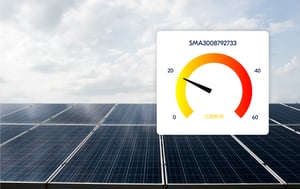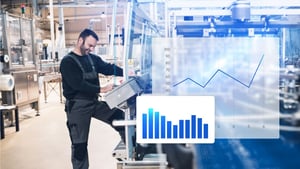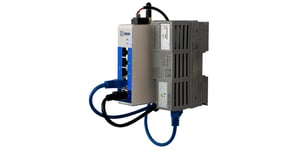- Home
- Knowledge hub
Data Logging, Monitoring and Dashboarding for Manufacturing Machines
6 min. read
Shelly Boom
How to gain Insights from Industrial Equipment, PLCs and Robots with PLC Monitoring
Manufacturers face many challenges. Except strong competition from globalization, they need to comply with strict industry regulations, reduce their environmental footprint, meet changing customer behaviour and much more. In order to meet all these conditions and still remain competitive, companies must address multiple requirements simultaneously. They have to adapt to changing conditions while meeting client expectations. Any deviation from these expectations results in a poor consumer experience and can create an opportunity for customers to move away.
Continuously improving machines and factory operations is thus of critical importance to manufacturers. But in order to quantify improvements, you have to be aware of your current machine performance. This is where PLC data logging and condition monitoring kicks in.
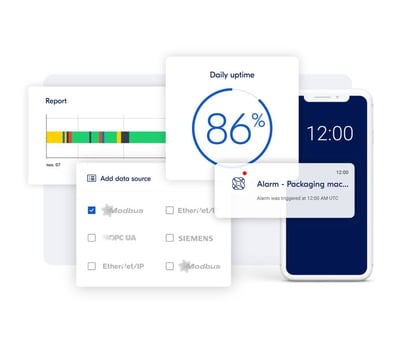
Manufacturing machine data logging for dashboards, monitoring and optimisation
Businesses often value intellectual property as an asset, but forget that their data may be another important industrial property just waiting to be monetized. Machine data may be one of the most underused and undervalued assets of any organization. This is pretty astonishing if you realize that some of the most important insights you can gain across IT and your business are hidden in that data: it contains a definitive record of all activity and behavior of your machines, peripheral devices, sensors, servers, servo drives, PLCs, HMIs, IP cameras, robots, networks and other industrial equipment, just waiting to be analyzed.

Machine data can tell you exactly how your machines are performing. It can tell you everything about the cycle time of the machine, malfunctions, downtime and operating time. In case of breakdowns, the data can reveal where, when and why it went wrong. It also allows you to keep track whether temperature, humidity and gas concentrations are constantly within the normal operating range. It can even reveal answers to more abstract questions, such as, which process variables have an affect on quality and yield, which process variables predict equipment failure or tell you whether product quality, quantity or accuracy meets expectations.
Answering these questions can give you a big leg up over competitors. Combining IoT with business intelligence can extend the uses cases of IIoT data in manufacturing to large scale industry 4.0 equipment or production monitoring. In other industries, such as oil and gas, use cases range from inventory or fleet management to supply chain optimization, worker safety or relate to core overall operational efficiency (OEE) and preventive or predictive maintenance.
To improve your overall equipment efficiency (OEE), you have to ingest data from different sources and turn that data into meaningful business metrics across your organization. But getting there is not easy and can be a time consuming struggle. One of the most difficult challenges is choosing the right software and hardware platform to get the most out of your data. Let’s find out if we can help you explore the best continuous data logging solution for your situation so you can conduct machine data acquisition, processing, analysis and forecasting.
The activity of machines and peripheral devices such as robots and sensors can generate large quantities of data. Generally speaking, machine data logging is considered the collection and recording of data from machines and devices without human involvement. Note however, that most data generated may not be all that interesting, as it’s mostly used to ensure normal operation. When using machine data acquisition, you use electronic devices, such as the IXrouter edge gateway, to collect and store data from one or more parameters from PLCs, HMIs, IPCs, frequency inverters or sensors and use the gathered IoT data for further analysis by sending it to the IXON Cloud.
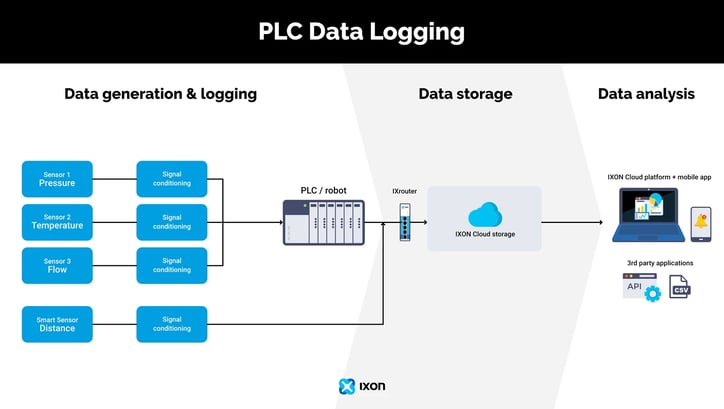 PLC Data Logging with IXON Cloud + IXrouter
PLC Data Logging with IXON Cloud + IXrouter
One of the largest pitfalls of machine data logging is collecting too much data. The data that you decide to collect for your production process should be data that is going to be useful to you in informing developments and improvements within your production workflow. Think carefully as to what you are trying to achieve and how you are going to use it to improve your production or process.
Now determine what machine data is needed to develop the performance parameters and key performance indicators (KPI’s) that help your company achieve these key business objectives. Establishing performance metrics and KPI’s, and using automated dashboards to display the relevant KPI’s and targets to factory staff are essential to a thriving business that will stand the test of time. For calculation, dashboarding of these metrics and KPI’s, you can use our API to transfer the data to extremely sophisticated partner solutions, like Tableau or Power BI.
There are a wide range of IoT data loggers available, from cheap stand-alone electronic devices that have a sample rate of once per second or slower and no internet connectivity, to connected industrial data loggers that can much handle faster sample rates. Connected data loggers have the added advantage that data is directly available, so you can get real-time insight into your machine operations, something that industrial control systems or automated process control systems only offer after a lot of programming, configuration and huge costs.
With simple electronic data loggers, all collected data is only available in the internal memory of the data logger. So each time you want access to your data, you have to go to the data logger’s location, set up a bluetooth or cable connection and transfer the data manually. If you need to do this regularly, the burden and operating cost is quite high and a networked setup may be better suited.
Networked industrial data loggers such as our IXrouter can also store data locally in an internal memory, but here it’s just intended to be a buffer memory when the internet connection is down. Usually data is directly transferred over a TLS-secured MQTT connection to IXONs Cloud Logging platform for further processing and analysis. The benefits of our SaaS solution is that we can provide the best performance, availability and security. For manufacturing companies it means they can focus on their operation and don’t need to worry about the security and availability of their data.
Note that the IXrouter extracts machine data in real time using native protocols to poll the data out of the PLC. IXON supports most common PLC protocols, like Siemens S7, Ethernet/IP, Modbus TCP, OPC-UA, MELSEC, BACnet, etc. The extensive protocol support makes it possible, for example, to retrieve data from a Siemens LOGO! PLC with Modbus TCP. For each data you want to retrieve, just create a tag inside our interface and associate this tag to the corresponding PLC register. The tag will then reflect the value of the register.
Based on the chosen formula (log on interval, log on change, or log on trigger), the IXrouter stores values in its temporary 8 GB memory. There, each data value is marked with a timestamp (based on the IXrouter’s internal clock) and synchronization status. A built-in reader checks the synchronization status of the values and sends unsynchronized data from the online data logger to the IXON Cloud, our smart Industrial IoT platform, when there’s an active internet connection and then updates the synchronization status.
Depending on the model the IXrouter can set up an internet connection using wifi, ethernet and/or 4g/lte and even use failover services to set up one or two fallback connections.
When there’s no internet connection and you don’t have a failover connection set up, all unsynchronized logging data is stored in its 8GB memory. This allows data to be logged offline for weeks at a time.
Storing data on the IXrouter is useful for situations where there is no internet available, such as on a ship or when your 4G connection fails. As soon as an active internet connection is available again, the IXrouter will send the data to the IXON Cloud.
Although it’s better (and cheaper) not to collect more information than strictly needed, in reality many machine builders, system integrators and end-users want to store as much machine data in the cloud as possible to gain better machine insights. Later on, they analyze the machine data to uncover new machine information, which is then used to improve machine processes. The emphasis on information is deliberate, because data is just a resource from which you can extract information. It’s really just a means to an end. Raw machine data says nothing about machine performance. It’s human interpretation processes that gives data meaning.
Imagine that you’re logging several variables for one of the machines you have out in the field. Obviously, you’d like to store as much data as possible to get a grip on your machine process. The ‘problem’ here is that low interval logging results in high amounts of data being transferred to, and stored in the cloud. This results in higher logging costs per machine.
Edge Aggregation allows the IXON’s edge device to log data at high speed and locally aggregate this data into one data sample, after which it is sent to the cloud for secure storage. This allows you to log accurately, while sending less data to the cloud.
Remember: without interpretation, data has zero meaning and loses its value. To turn machine data into valuable information, it is necessary to process and analyse the machine data and display the result on custom dashboards. So now your field-level machine production data has been made available on IXON Cloud, it’s time to turn it into management-level information. With drag & drop widget-based PLC dashboards, your data is visualised into condition monitoring reports in no time. Depending on the type of information you want to visualise you can generate Data reports or Live monitors:
You can also export the data if you’re looking for even more in-depth analysis. Simply use webhooks or the API to integrate IXON Cloud with your favorite big data analytics, service, planning or management tool. This way you can use it to improve maintenance of your machine from regular to more accurate maintenance levels.
Last but not least, your machine data can be used to get notifications about important machine events, so you’re instantly aware of machine malfunctions.
